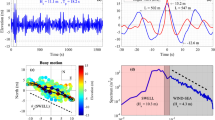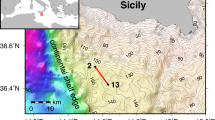Abstract
THE common methods of investigation of a high sea permit the height and the length of waves to be measured, but do not give any means of determining the changes of form of the wave, which can sometimes differ considerably from the simple form of a trochoid. “Forced waves” especially undergo deformation inasmuch as their steepness has often to be left out of account. Precise stereo-photogram-metric methods are always complicated, cumbersome and slow, which reduces their applicability to large amounts of material, as in other regions of geophysics. In such cases, when comparisons of the steepness of waves have to be made with large masses (as in the comparison of ocean and smaller sea waves) in order to study the relations between it and the wind-velocity, etc., the following method can be used.
This is a preview of subscription content, access via your institution
Access options
Subscribe to this journal
Receive 51 print issues and online access
$199.00 per year
only $3.90 per issue
Buy this article
- Purchase on Springer Link
- Instant access to full article PDF
Prices may be subject to local taxes which are calculated during checkout
Similar content being viewed by others
Author information
Authors and Affiliations
Rights and permissions
About this article
Cite this article
SHOULEJKIN, W. A New Method of Investigating Sea Waves. Nature 114, 498–499 (1924). https://doi.org/10.1038/114498a0
Issue Date:
DOI: https://doi.org/10.1038/114498a0
Comments
By submitting a comment you agree to abide by our Terms and Community Guidelines. If you find something abusive or that does not comply with our terms or guidelines please flag it as inappropriate.



